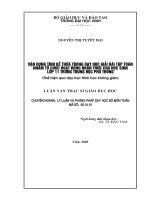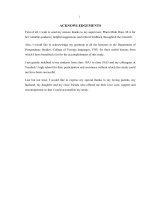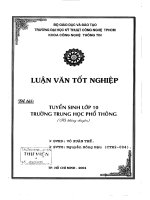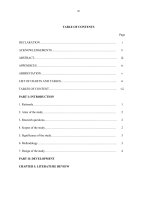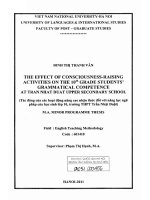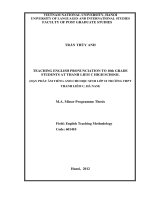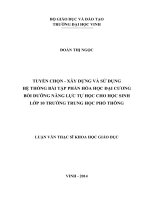TÁC ĐỘNG CỦA HỌC TẬP HỢP TÁC ĐẾN NĂNG LỰC NÓI CỦA HỌC SINH LỚP 10 TRƯỜNG TRUNG HỌC PHỔ THÔNG PHỐ YÊN
Bạn đang xem bản rút gọn của tài liệu. Xem và tải ngay bản đầy đủ của tài liệu tại đây (486.26 KB, 8 trang )
<span class='text_page_counter'>(1)</span><div class='page_container' data-page=1>
<b>IMPACT OF COOPERATIVE LEARNING ON SPEAKING COMPETENCE OF </b>
<b>10TH GRADE STUDENTS IN PHO YEN HIGH SCHOOL </b>
<b>Nguyen Thi Thuy1*, Nguyen Thi Minh Loan2 </b>
<i>1</i>
<i>Pho Yen high school, 2 TNU - School of Foreign Languages </i>
ABSTRACT
Over the past decade, cooperative learning has appeared as one of the leading approaches in
speaking environments. In the teaching context at Pho Yen high school, there existed some
problems for speaking skills that the researcher came across in helping the students to speak in the
classroom such as shyness when expressing personal opinions, passivity in speaking activities, and
so on. Therefore, the aims of the research is to evaluate cooperative learning’s effects on the
students’ speaking competence and explore their attitudes towards this approach. There are forty
10th grade students, including 19 males and 21 females at 15 year old, taking part in the research.
The authors used a combination of two data collection instruments: a speaking test and a
questionnaire. The study has shown the significant improvements of students’ English speaking
performance after utilizing cooperative learning. Moreover, most of the students expressed a
positive attitude towards applying cooperative learning and an interest in group work, which
demonstrate that they believe in its positive effects. Besides, some suggestions were also proposed
to reduce the shortcomings of using cooperative learning in English speaking classes to enhance
the potentiality of this method and make it more interesting, meaningful and learning-centered.
<i><b>Keywords: learner-centered; cooperative learning; speaking competence; 10</b>th grade students; </i>
<i><b>speaking skills </b></i>
<i><b>Received: 23/9/2020; Revised: 15/10/2020; Published: 20/10/2020</b></i>
<b>TÁC ĐỘNG CỦA HỌC TẬP HỢP TÁC ĐẾN NĂNG LỰC NÓI </b>
<b>CỦA HỌC SINH LỚP 10 TRƯỜNG TRUNG HỌC PHỔ THÔNG PHỐ YÊN </b>
<b>Nguyễn Thị Thủy1*<sub>, Nguyễn Thị Minh Loan</sub>2 </b>
<i>1<sub>Trường Trung học Phổ thông Phổ Yên, </sub>2<sub>Khoa Ngoại ngữ - ĐH Thái Nguyên </sub></i>
TÓM TẮT
Trong thập kỷ qua, học tập hợp tác được nhiều nhà giáo dục quan tâm nghiên cứu và ứng dụng
như một trong những cách tiếp cận hàng đầu trong môi trường nói. Trong bối cảnh giảng dạy ở
trường Trung học Phổ thơng Phổ n, có một số vấn đề cịn tồn tại đối với kỹ năng nói mà nhà
nghiên cứu gặp phải trong quá trình giúp học sinh nói trong lớp học như việc ngại ngùng khi phát
biểu ý kiến cá nhân, thụ động trong hoạt động phát biểu, v.v. Do đó, mục đích của nghiên cứu là
đánh giá tác động của học tập hợp tác đối với năng lực nói của học sinh và khám phá thái độ của
họ đối với phương pháp này. Đối tượng tham gia nghiên cứu là 40 em học sinh lớp 10, bao gồm 19
nam và 21 nữ đều có độ tuổi là 15. Nghiên cứu sử dụng kết hợp hai công cụ thu thập dữ liệu: bài
kiểm tra nói và bảng câu hỏi. Nghiên cứu đã chỉ ra những thay đổi đáng kể về khả năng nói tiếng
Anh của học sinh so với trước khi sử dụng phương pháp học hợp tác. Hơn nữa, hầu hết các sinh
viên đều bày tỏ thái độ tích cực đối với việc áp dụng phương pháp học hợp tác và quan tâm đến
làm việc nhóm, điều này chứng tỏ rằng họ tin vào những tác động tích cực của nó. Bên cạnh đó,
một số gợi ý được đưa ra để giảm thiểu những thiếu sót của việc sử dụng phương pháp học hợp tác
trong các lớp học nói tiếng Anh nhằm nâng cao tiềm năng của phương pháp này và làm cho nó trở
nên thú vị, ý nghĩa và lấy người học làm trung tâm.
<i><b>Từ khóa: người học làm trung tâm; học tập hợp tác; năng lực nói; học sinh khối 10; kĩ năng nói </b></i>
<i><b>Ngày nhận bài: 23/9/2020; Ngày hồn thiện: 15/10/2020; Ngày đăng: 20/10/2020 </b></i>
</div>
<span class='text_page_counter'>(2)</span><div class='page_container' data-page=2>
<b>1. Introduction </b>
As a means of communication, speaking is
one of the most crucial skills to be improved
and boosted [1]. Recent pedagogical practices
in English language education have reflected
the transformation from a teacher-centered
learning model to a learner-centered learning
model. In addition to applying methods and
strategies for learner-centered approach, a
promising method to traditional speaking
instruction called the Cooperative Learning
Approach should be applied to strengthen
learners’ speaking capacity. Ning [2] further
claimed that this method works as the
alternative way of teaching which allows
students to have more speaking time and
social interaction with others. Hence,
cooperative learning gives students
opportunities to interact and vary their
learning styles so that they can develop their
speaking skills naturally [3].
Over the past decade, cooperative learning
has appeared as one of the leading approaches
in speaking environments. One critical reason
for this tendency is that a number of studies in
different settings have suggested that
language learners tend to achieve higher
academic performance, self-esteem and
greater comprehension when they are
involved in cooperative group activities [4].
Rather than working individually, cooperative
learning method can be achieved through
interdependent tasks and activities. This
feature makes cooperative learning better for
students’ achievements compared to
conventional methods. It is clear that while
students who work individually tend to
compete with their peers to gain higher scores
and other rewards, cooperative learning
allows success and achievements for all
members. Different from individual tasks,
cooperative learning boosts competition
among different groups which can be a
solution for various problems.
In the teaching context at Pho Yen high
school, there existed some problems for
speaking skill that the researcher came across
in helping the students speak in the
classroom. Inhibition was the first problem
that the students encountered in class. They
were worried about making mistakes and
afraid of being criticized by other people
while speaking. They were also ashamed of
the other students’ attention towards
themselves. The second problem in the
speaking class was that students are still
passive in participating, especially working in
small groups with other students. During the
process of teaching English at Pho Yen high
school, the researcher also realized the
problems in the students' group work. To
begin with, some students were not very
hard-working and inactive to cooperate in groups
as well as take responsibilities while working
in a team. Next, team members sometimes
disagreed with each other, which led to
stressful learning atmosphere. Besides, team
members lacked skills to assign their tasks,
resulting in inefficiency for teamwork
activities. Furthermore, some students were
still passive and lacked self-awareness when
working in groups. Finally, sometimes,
students who were assigned to be the leaders
of their teams tended to follow a style that
imposed their personal opinions rather than
listening to ideas from other members.
Based on the current existing issues, this
research was conducted to investigate the
influence and effectiveness of cooperative
learning approach to teaching speaking skill
to see whether this method could enhance
students’ speaking competence or not.
Therefore, the researcher decided to conduct
the study “Using cooperative learning
approach to enhance 10th grade students’
English competence: An action research at
Pho Yen high school”.
<b>2. Methodology </b>
<i><b>2.1. The participants </b></i>
</div>
<span class='text_page_counter'>(3)</span><div class='page_container' data-page=3>
part in the research. They had been studying
English as a compulsory school subject for at
least 7 years. The students were between the
elementary and pre-intermediate levels. By the
time of the study, all of them had four years of
learning English at secondary school. They
were at the beginning of the second term.
<i><b>2.2. Data collection instruments </b></i>
The study used a combination of two data
collection instruments:
• A speaking test
• A questionnaire
<i>2.2.1. Speaking test </i>
The speaking test was adapted from National
Geographic Oral Placement Test. This test
consisted of an interview based on
conversational prompts to be presented by the
interviewer, and was accompanied by Oral
Assessment Guidelines to help interviewers
determine the appropriate level of the student.
The selected students were required to answer
thirty-three questions belonging to nine
different topics from Elementary to Advanced
level to check their speaking competence. The
questions in each topic were divided into 2
types: close-ended question and open-ended
questions. No grammar or other language
skills were mentioned in the test. Each answer
was assessed on a scale from 1 to 5,
corresponding to English speaking ability
from Low to Excellent. The test duration was
about 20 minutes.
For the purpose of achieving reliable results,
the researcher also invited another teacher of
English at Pho Yen high school to assess the
students’ speaking competence. This teacher
was trained to use the rubric of the test before
the assessment. Throughout the rubric of the
test, two examiners, including the researcher
and invited teacher of English, assessed the
speaking ability of the students. The contents
of the speaking tests were recorded so that the
examiners would be able to check the results
of the test again. Mark allocation was 9 points
in total, which meant 1 point for each item.
This speaking test was employed as both the
pre-test and post-test to measure the students'
speaking competence.
Before the application of the intervention, the
students in the class were given a speaking
test as the pre-test. Ten weeks later, when the
students finished 9 sessions, they were given
the same speaking test as the post-test.
<i>2.2.2. Questionnaire </i>
The questionnaire which was used in this
research was adapted from the questionnaire
<b>by McLeish [5]. </b>
The questionnaire gathered the participants’
feedback relating to cooperative learning,
including the following aspects such as benefits
of using cooperative learning and attitudes of
participants toward cooperative learning.
The questionnaire was designed in a mixed
format, including 4-point Likert statements,
close-ended questions and open-ended
questions. The questionnaire was divided into
4 sections. In section 1, students answered
two questions about general information (full
name and gender). In section 2, the researcher
designed some multiple-choice questions to
find out the current situations about group
assignments or activities at Pho Yen high
school. In section 3, students indicated how
much they agreed with fourteen statements on
a scale from 1 to 5, corresponding to attitude
towards using cooperative learning in English
speaking class from strongly disagree to
strongly agree. In section 4, the researcher
designed open-ended questions to collect
recommendations from students about group
activities. The questionnaire was given at the
end of the intervention.
<i><b>2.3. Procedure of data collection </b></i>
<i>2.3.1. Planning </i>
</div>
<span class='text_page_counter'>(4)</span><div class='page_container' data-page=4>
about the speaking problems collected and
analyzed, an action plan was developed. The
researcher planned and prepared what
materials that would be used, how to use
cooperative learning approach to teach
speaking lessons, and how long this
intervention would take. Besides, the
teacher-researcher explained to the headmaster the
envisaged process during the research to gain
his understanding and cooperation. Finally,
the researcher designed lesson plans using the
cooperative learning model.
<i>2.3.2. Action </i>
In the second stage, the teacher-researcher
tried out the ideas of cooperative learning
approach in teaching speaking.
The intervention lasted 9 weeks from March,
23rd to May, 24th 2020. In the first 5 weeks,
the students studied English speaking lessons
from unit 9 to unit 13 via the online
application named “Zoom” due to Covid
epidemic. From unit 14 to unit 16, the
students joined English speaking classes with
applying cooperative learning in the
classroom at Pho Yen high school.
The students learned English speaking
periods via cooperative learning through
seven phases:
Phase 1: Delivered goals and Student
motivated
In this phase, the teacher told about the
objectives of the speaking lesson, and
motivated the students in the speaking
lessons.
Phase 2: Given/ Delivered Information
In the speaking lessons, class presentation by
the teacher was via whole-class instruction
related to vocabulary, grammar, or replays of
audiovisual materials.
Phase 3: Student organizing into study group
All students were divided into different
groups of 5 people (mixed from their
achievement, gender, and so on) to work with
on alternative weeks during the study duration,
and gave each group a different number. The
students in a group letter off A, B, C, etc.
Therefore, each person had a specific and
distinct number and letter (such as 3B). All
students were responsible for the individual
learning or in groups, and they were in
discussions regarding the teacher's lessons and
were sure every member of the group would
understand the delivered material.
Phase 4: Giving tasks
The teacher gave tasks toward groups for
doing by member. The students were
encouraged to work together the task, and
they coordinated their efforts to accomplish
the tasks assigned by the teacher.
Phase 5: Guiding/ Helping groups on work
and study
The teacher gave instructions toward the
group members who had understood. After
that, these students could help their friends in
the group to understand the material. The
teacher asked their students to encourage his
teammates to express opinions, which led to
less stressful atmosphere. The group members
actively co-ordinated their efforts, ensuring
that others had the opportunity to contribute,
provide help and assistance when it was
needed, and encourage others’ efforts. The
teammates worked on the given task within a
given time limit. The task was based on the
textbook learning materials, or a team
assignment to be completed within one week.
In terms of assignment, the teammates needed
to reach an agreement in advance when and
where they meet, how they assign the tasks to
different members according to their
strengths, interests and competence and add
some other learning resources if needed.
Phase 6: Evaluation
</div>
<span class='text_page_counter'>(5)</span><div class='page_container' data-page=5>
suggestions and grades. After that, other
students were selected to represent and report
to the class.
Phase 7: Giving Appreciation
The teacher looked all the way for
appreciating the students’ efforts individually
and by group.
<i>2.3.3. Observation </i>
During the third stage, the teacher-researcher
concentrated on gathering information about
the actions taken carefully and systematically.
In this study, the researcher used the speaking
test and questionnaire as the data collection
instruments.
Before starting the intervention, the students
did the test. From the results of the
pre-test, the researcher determined the levels of
the student before applying cooperative
learning in the speaking class.
At the end of the intervention, the post-test of
oral performance and the questionnaire to
investigate the students’ attitude towards
cooperative learning would be administered
to the students.
<i>2.3.4. Reflection </i>
In this stage, based on the data analysis, the
researcher made reflections about the action
implementation. The reflection of the actions
indicated the success or the failure of the
action research. Therefore, the researcher
would have recommendations for both
teachers and students.
<b>3. Results and discussion </b>
<i><b>3.1. Results of the speaking test </b></i>
As seen from Table 1, the pre-test scores
ranged from 4.0 to 5.8 with the mean of
4.880. It means that students’ speaking
competence before applying cooperative
learning was at poor levels whereas the scores
of the post-test which applied cooperative
learning activities ranged from 4.0 to 7.2 with
the mean of 5.565. This proved that there was
a significant difference between mean scores
of the two tests. The students’ speaking
performance had been improved
considerably. This significant improvement
could be attributed to the effectiveness of
cooperative learning applied in the study.
<i><b>3.2. Data from the questionnaire for students </b></i>
Forty participants of 10th grade students at
Pho Yen high school completed the
questionnaire to investigate their attitudes
toward the use of cooperative learning in
speaking classes. In order to facilitate the
analysis, the 5-level statement of perception
in the questionnaire – Strongly Agree, Agree,
Undecided, Disagree, Strongly Disagree –
were regrouped into three main categories:
Disagree, Undecided and Agree.
Table 2 shows the result of the questionnaire
regarding the students’ attitude toward using
cooperative learning in speaking classes.
From table 2, it is clear that 70% of the
students agreed that they achieved more
within the group than on their own, 12.5%
remained neutral while 17.5% disagreed. 85%
of the students agreed that they willingly
participated in group activities, 5% remained
neutral, while 10% disagreed. 90% agreed
that cooperative learning improved their
attitude to work, 7.5% renewed neutral, while
2.5% disagreed. 82.5% agreed that
cooperative learning enhanced socialization,
12.5% remained neutral, while 5% disagreed.
<i><b>Table 1. Descriptive statistics of the pre-test and post-test scores </b></i>
<b>N </b> <b>Minimum </b> <b>Maximum </b> <b>Mean </b> <b>Std. Deviation </b>
<b>Pre-test </b>
<b>Post-test </b>
<b>Valid N </b>
<b>(listwise) </b>
40
40
4.0
4.0
5.8
7.2
4.880
5.565
</div>
<span class='text_page_counter'>(6)</span><div class='page_container' data-page=6>
<i><b>Table 2. Students’ attitude toward using cooperative learning </b></i>
<b>Statements </b> <b>Agree </b> <b>Undecided </b> <b>Disagree </b>
<b>1 When I work together, I achieve more than when I work alone. </b> 70% 12.5% 17.5%
<b>2 I willingly participate in cooperative learning activities. </b> 85% 5% 10%
<b>3 Cooperative learning can improve my attitude towards work. </b> 90% 7.5% 2.5%
<b>4 Cooperative learning helps me to socialize more. </b> 82.5% 12.5% 5%
<i><b>Table 3. The students’ views of using cooperative learning</b></i>
<b>Statements </b> <b>Agree </b> <b>Undecided </b> <b>Disagree </b>
5 Cooperative learning enhances good working relationships
<b>among students. </b> 80% 12.5% 7.5%
6 <b>Cooperative learning enhances class participation. </b> 87.5% 2.5% 10%
7 <b>Creativity is facilitated in the group setting. </b> 75% 15% 10%
8 <b>Group activities make the learning experience easier. </b> 87.5% 7.5% 5%
Table 3 indicates that 80% of the students
agreed that their working relationships have
been enhanced through cooperative learning,
while 7.5% disagreed. 87.5% of the students
agreed cooperative learning could improve
class participation, while 10% disagreed.
75% of the students agreed that when they
studied with cooperative learning, creativity
was facilitated, while 10% disagreed. 87.5%
of the students agreed that group activities
made the learning experience easier, while
5% disagreed.
<i><b>3.3. Discussion </b></i>
Based on the results of the statistical analysis
reported in the previous sections, this section
focused on the discussion of the major
findings related to cooperative learning in
learning English speaking.
As mentioned above, the researcher had been
concerned in finding out the effectiveness of
using cooperative learning to improve 10th
grade students' English speaking competence.
The researcher applied the cooperative
learning to organize study activities in
speaking lessons to the students of grade 10 at
Pho Yen high school where she worked.
During the time when the research was
carried out, the researcher made her effort to
search for the answers for the two research
questions by analyzing collected data from
the pre-tests, post-test, and questionnaire.
Through analyzing the data collected from the
speaking tests, it can be seen that using
cooperative learning had positive effects on
the students’ speaking performance. Thanks
to sharing ideas and information among
members in group work, students might feel
more confident when speaking English, this
helps them improve their speaking
competence. It was clearly shown in the
collected data from the pre-tests and post-test
that there was a significant difference in the
distribution of points in the pre-test and the
post test. This proved that there was an
obvious improvement of the participants’
speaking competence after they had learned
English speaking by applying cooperative
learning. The above statistics implied that
using cooperative learning in speaking lessons
was effective in both short-term and long-term.
</div>
<span class='text_page_counter'>(7)</span><div class='page_container' data-page=7>
socialization; strengthening working
relationships through collaborative learning;
improve class participation; with creative
conditions; have an easier learning experience.
Most students in class 10C1 presented their
positive attitudes towards the application of
cooperative learning and their interest towards
group activities, which proved that they
believed in its positive effects.
In general, most of the students participating
in the study exposed positive attitude
towards cooperative learning used in English
speaking lessons.
<b>4. Conclusions and recommendations </b>
<i><b>4.1. Conclusions </b></i>
As expected by the researcher, there were
changes as a result of the actions. The
changes were both in the way of thinking and
in the behavior of the involved members. The
changes were related to the following:
Firstly, it was undeniable that cooperative
learning had a positive effect on the students’
English speaking competence. At the second
term of school year 2019-2020, 40 10th
grade students had a chance to learn English
speaking through cooperative learning under
the researcher’s specific instruction. Data
from the score of the pre-test and post-test of
the participants demonstrated that
cooperative learning was beneficial to
improve the 10th grade students’ English
speaking competence effectively.
Secondly, through the questionnaire and
observation checklists, it can be seen that most
of the students expressed a positive attitude
towards applying collaborative learning and an
interest in group work, which demonstrated
that they believed in its positive effects.
In conclusion, the researcher would like to
give some efficient suggestions on ways to
improving the effectiveness of cooperative
learning in studying English speaking.
Hopefully, this study might be helpful for
10th grade students and teachers of English to
develop English speaking competence.
<i><b>4.2. Limitations of the study </b></i>
Although the study has provided a
comparatively detailed description of the
cooperative learning in improving speaking
competence of the 10th grade students, there
are still some limitations of the study.
First, when implementing the action plan,
some students were not aware of the
importance of cooperative learning. Hence,
some participants did not concentrate on the
tasks, which made the speaking lessons
noisy and some of them used mother tongue
in the class.
Second, the study was carried out in a limited
time of 11 weeks. The study would be more
reliable if the research had been taken in a
longer time. The longer time is a key factor
creating the more success for students’
speaking competence.
Third, the results were particular from one
class (10C1) at Pho Yen Upper Secondary
School. If the action research was implemented
in more classes, the results of the study would
be generalized to a larger population.
<i><b>4.3. Recommendations </b></i>
Based on the research results, some
suggestions are referred to the English
teachers of 10th grade of Pho Yen high
school, and other researchers.
<i>4.3.1. The English teacher </i>
Teachers should have specific instruction,
focusing on learning content and tasks when
using cooperative learning to teach in English
speaking lessons for students because they are
not proficient to provide sufficient input. At
the end of learning activities, teachers should
concentrate on assessing and correcting
students’ mistakes to improve students'
speaking competence in a timely manner.
</div>
<span class='text_page_counter'>(8)</span><div class='page_container' data-page=8>
philosophy of cooperative learning methods
of implementing cooperative learning
activities. Cooperative learning activities can
be effective when teachers have opportunity
to work together and learn expertise and
experience from each other. When teachers
observe and contribute to each other's lessons,
they can acquire and develop teaching
strategies based on cooperative learning
activities appropriate to their own situations.
The English teachers need to give more
opportunities for the students to practice
speaking in the class. The enjoyable and
non-threatening atmosphere, interesting media
should also be made to make students more
interested in the lesson. The teacher can use
the activities such as think-pair-share,
numbered head together, two stay two stay,
and inside outside circle. When conducting
the cooperative activities, the teacher should
pay attention to the class management since
in cooperative learning the students tend to
move around the class to have a discussion
with others.
<i>4.3.2. Other researchers </i>
This research focuses on improving the
students’ speaking skills using cooperative
learning activities. There are still many
activities that can be used to teach speaking.
For the other researchers, it is necessary to
look for and try out other activities so that the
learning activities will be more various.
Furthermore, in doing similar research, the
speaking materials and the speaking tasks
could be modified based on the students’
learning ability and interest.
REFERENCES
[1]. L. M. Leong and S. M. Ahmadi, “An analysis
of factors influencing learner’s English
<i>speaking skill,” International Journal Of </i>
<i>Research in English Education, vol. 2, no.1, </i>
pp. 1-34, 2017.
[2]. H. Ning and G. Hornby, “The effectiveness of
coop-erative learning in teaching English to
<i>Chinese tertiary learner,” Effective Education, </i>
vol. 2, no. 3, pp. 112–129, 2010.
doi:10.1080/19415532.2010.522792.
[3]. Y. A. Al-Sohbani, “An exploration of english
language teaching pedagogy in secondary
<i>Yemeni education: A case study,” International </i>
<i>Journal of English Language and Translation </i>
<i>Studies, vol. 1, no. 3, pp. 40–55, 2013. </i>
[4]. A. Alam, M. Uddin, L. Hossain, and J. Hamra,
“A study of physician collaborations through
social network and exponential random
<i>graph,” BMC Health Services Research, vol. </i>
13, no. 1, pp. 1-14, 2013.
</div>
<!--links-->
